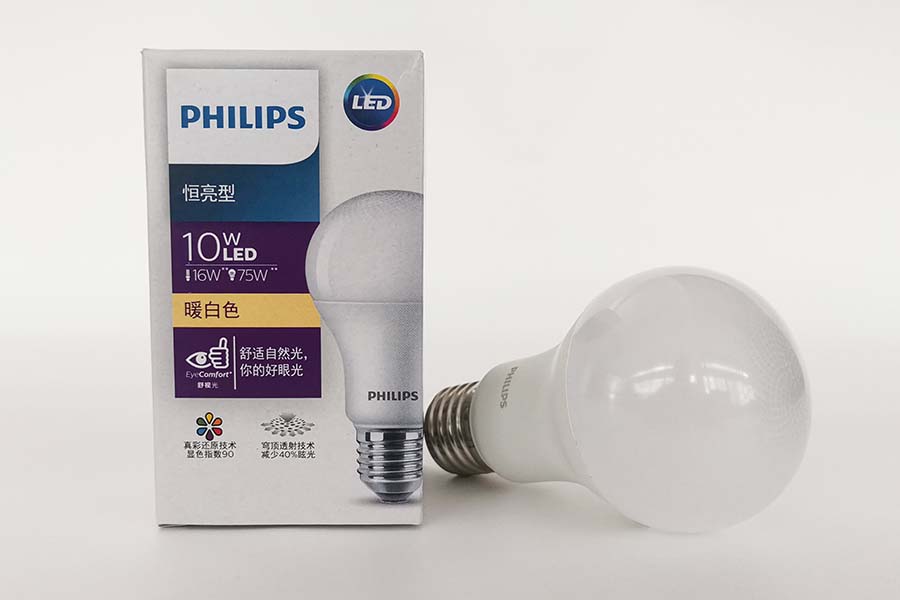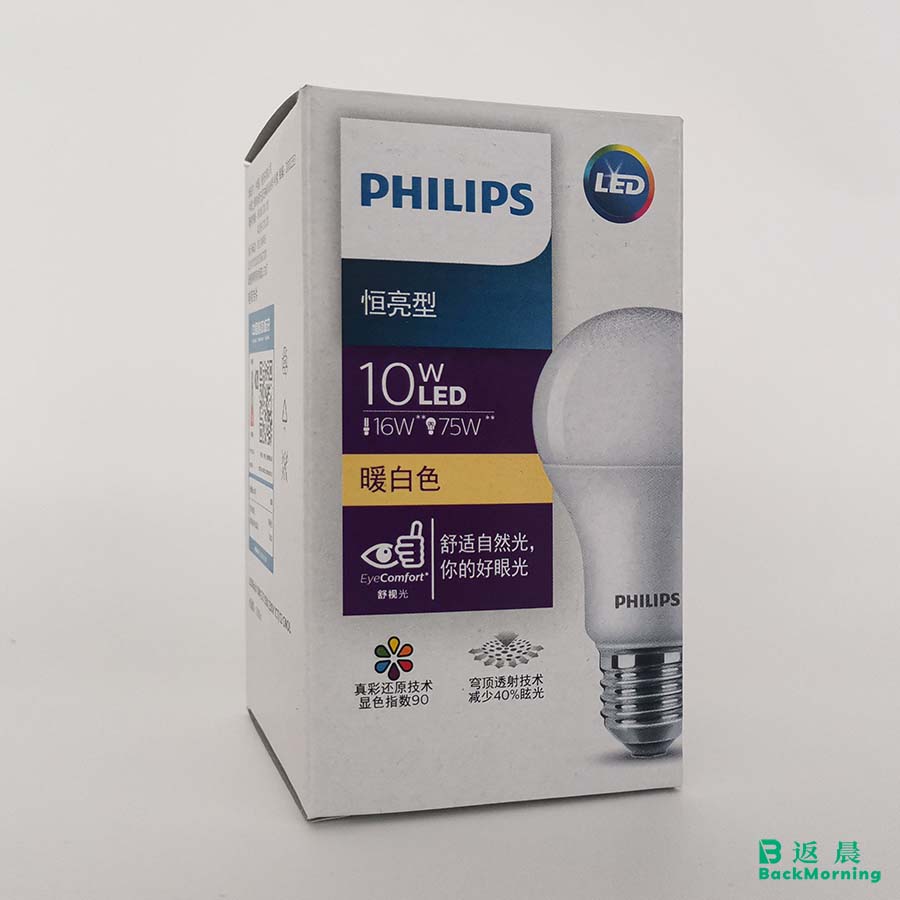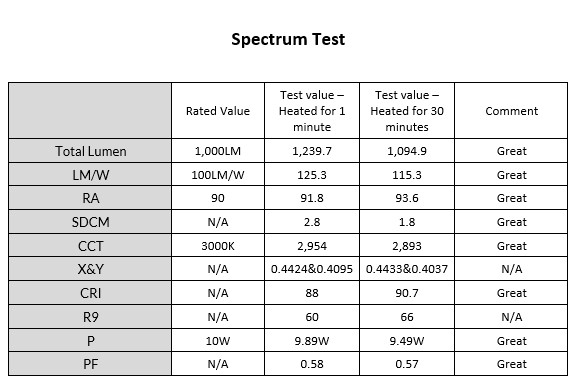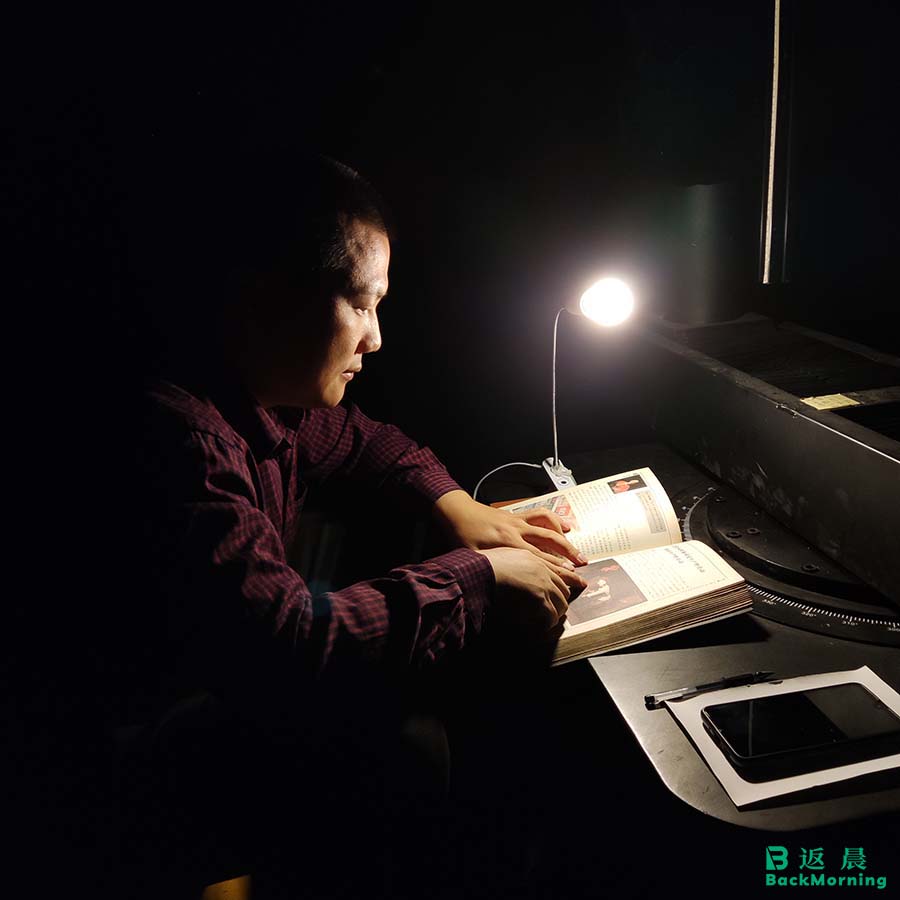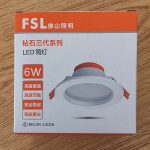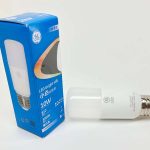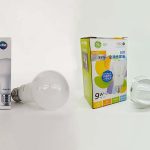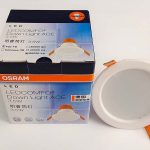Philips is one of the famous brands that have been producing quality LED light bulbs for years.
These light bulbs are widely installed: in homes, offices, shopping malls, etc.
Usually, the prices of Philips’ LED lights are a little more expensive than nonbrands.
Probably you wonder if many people pick their LED lights because of their quality.
Or simply because of their marketing strategies.
It’s not easy to draw a conclusion about this topic.
BackMorning is a third-party quality inspection company focusing on the LED lighting industry.
And we’ve been working with some reputable brands for years.
We decide to do some tests with a sample of their LED light bulbs.
In this way, we can use our knowledge, skills, and experience to reveal some truth.
That should be helpful for you to better understand this subject.
Below is some basic information about this sample.
- Model: Philips EyeComfort
- Specifications: 10W, 3,000K, 1,000lm, 220-240Vac, BPZ1000-930E27
1. First Thing to Consider Before You Buy
LED light bulbs are a great way to save money and energy.
They last longer than traditional incandescent or halogen bulbs.
Use less energy and they’re more efficient.
- The sales package indicates that it has a wattage of 10W.
- Comparable to a traditional incandescent light bulb of 75W.
- An amazing comparison regarding the energy efficiency of 2 types of technologies.
Typical applications of LED light bulbs can be as below:
- For general lighting purposes in the living rooms, bedrooms, and kitchens.
- As accent lights for home decoration, including dining room tables and cabinets, windowsills, etc.
- For commercial lighting purposes, such as retail shops, restaurants, and office buildings, etc.
Usually, LED light bulbs are used as light sources.
Therefore, it’d be good to pick the ones that are bright enough.
This Philips light bulb is worth considering for its rated wattage and lumens.
2. First Impression on Overall Design
It has a housing made of plastic-coated aluminum, rather than plastics.
This is a better material for more efficient heat dissipation.
Heat dissipation is a critical factor that determines the life spans of various electronic products.
As a rule of thumb, if an electronic component works at a lower temperature, it has a longer life span.
And good heat dissipation is unquestionably helpful for this purpose.
For this reason, we can say this light bulb has a solid foundation for a long life span.
Meanwhile, an LED light bulb is a point light source.
And this type of light source has a disadvantage of its own.
That is, the light might be a little bit too harsh in some cases.
However, the sales package indicates it has a special design for its PC cover.
And this design reduces the light’s glare by as much as 40%.
Visually, they make some lasered patterns on the top of the cover.
This special pattern varies the thickness of the material right in front of the LEDs.
It functions as a diffuser to reduce the harshness of the brightness point.
This feature can offer benefits in various cases.
- The light bulb is directly visible for your installation.
- The floor is glossy and reflective, and you will install the light bulb above such a floor.
- The light bulb will be a little bit too close to the heads.
However, this feature won’t be so beneficial if the light bulb is not directly visible for your installation.
- A typical example is when you have a floor light.
- And the light bulb is installed inside its shade.
The words above are what we wish to tell you about its first impression.
After the first impression, we will talk about the electrical performance and the spectrum test.
In plain English, we are going to talk about this Philips light bulb from 2 aspects.
- The quality of its electronic hardware
- The quality of the light it produces
We use professional instruments to test this Philips light bulb BPZ1000-930E27.
BackMorning does such tests using the same instruments for some other household names.
And we will explain each term in detail.
3. Voltage Range
Voltage is an essential parameter for various electronic products.
As for LED lights, make sure they work properly within a voltage range.
Avoid those which won’t work if the input voltage changes a little bit.
There is a technical reason behind this suggestion.
Probably you don’t know it yet.
The power grid doesn’t provide electricity at a fixed value – like exactly 220V all the time.
Actually, it supplies electricity within a voltage range.
It’s important to make sure the light will work normally within its rated voltage range.
That means the LED light won’t flick when the input voltage rises or drops within its rated range.
This is the bottom line for the quality of LED lights.
As for the Philips LED light bulb sample, it doesn’t flick within its applicable voltage 220-240Vac.
4. Spectrum Test
Next, we will tell you the quality of its light with numbers one by one.
Below is the data that we’ve got after testing it with an integrating sphere.
By the way, these numbers are not possible to obtain if you just check an LED light visually.
You will need an instrument and put the light inside to measure it.
Meanwhile, you will also need the knowledge, skills and experience to properly set up the test.
That’s why it’d be better to work with a third-party quality inspection company like BackMorning.
And one more thing to mention.
The performance of electronic products may go down to a certain extent as time goes by.
Therefore, we collect the data 2 times respectively.
- One is when the light goes on for 1 minute.
- The other is after 30 minutes.
In this case, the data will be more reliable.
1). Total Lumen
The term Lumen is a useful term for measuring the brightness of a light bulb.
The higher the number of Lumens, the brighter the light bulb.
The amount of Lumens produced by an LED bulb varies greatly depending on its size and design.
If you want a brighter light bulb, pick the one with a bigger Lumen value, rather than a bigger wattage value.
Here we can see that the sample produces:
- 1,239.7 Lumens at 1 minute, which is about 24% more than its rated value 1,000 Lumens.
- 1,094.9 Lumens at 3 minute, which is about 9.5% above its rated value 1,000 Lumens.
This LED light bulb gives you more brightness for its price.
We can say it’s worth considering from this point of view.
2). LM/W
Another important factor when choosing an LED bulb is its Lumen output.
It is a measurement of how much light a bulb produces, measured in Lumen/Wattage.
The higher the number is, the brighter it will be.
A bigger number of LM/W is more favorable than a smaller number.
You want to choose a more energy-efficient light bulb after all.
Philips indicates a rated value of 100 for its LM/W on the sales package.
- The tested value is 125.3 LM/W, measured at 1 minute
- And the 2nd value is 115.3, measured at 30 minutes
We can say this light bulb is energy efficient.
Choose LED lights that are more energy efficient.
And they will save you money in the long run.
3). RA
The parameter Ra measures the color rendering property of an LED light bulb.
It measures the ability of a light source to reveal colors of objects in contrast to a natural light source.
Needless to say, you already notice the same object looks different in different lighting conditions.
There are some installations requiring sufficient brightness and good color rendering.
For example, in shopping malls, it’d be better for buyers can recognize the colors properly.
Even for your homes and offices, it’d be better to have a better color rendering for reading.
For this reason, the value of Ra is an important parameter for measuring the quality of an LED light bulb.
Generally speaking, a bigger value of the color rendering index means better quality of the LED light.
This Philips light bulb indicates a rated value 90 for as its Ra.
- The tested value is 91.8, measured at 1 minute
- And the value is 93.6, measured at 30 minutes.
It has great color rendering performance.
We can say it’s fit for some demanding applications.
An example is DIY product photography projects.
4). SDCM
SDCM is an acronym that stands for Standard Deviation Color Matching.
It is a measure of how far the color of light emitted by a LED light bulb deviates from the target color.
Therefore, the lower the number of SDCM, the better for the LED light bulb.
You want your LED light bulbs to be as consistent in their color and brightness as possible.
To understand this concept better, let us give you an example.
If you have seen many LED lights installed on the ceiling of a hall or something, it’s possible you have noticed that they look somewhat different.
- Most lights may have a look similar to the natural white.
- But some lights may appear to be blue.
- While some may appear to be darker.
This is because, technically speaking, their SDCM is too big.
Will you be happy to see such a lighting effect?
That’s why we recommend smaller SDCM values.
- Tested value of SDCM value is 2.8, measured at 1 minute
- And another value 1.8, measured at 30 minutes
This is a great result.
Worth considering if you need to install multiple of them together.
5). CCT
CCT stands for Correlated Color Temperature.
It is a way of measuring the color of a light source.
The higher the number, the cooler (bluer) the light looks.
- The CCT value is measured in Kelvin (K).
- A CCT of 2,700K is more yellowish than 5,000K which is more white.
A common misconception is that higher K values mean more heat.
However, this is not true for LED lights.
We use the appearance of different CCT values to create different feelings.
But it has nothing to do with the physical temperatures (heat).
- The rated CCT value of this LED light bulb is 3,000K
- While the tested CCT value is 2,954K, measured at 1 minute
- And 2,893K, measured at 30 minutes
We can say Philips has indicated this parameter accurately.
6). Wattage
Wattage indicates how much electricity that light bulb uses.
It is the same concept as how much gas a car uses.
- The rated value for this Philips light bulb is 10W.
- The tested value is 9.89W, measured at 1 minute
- While the tested value is 9.49W, measured at 30 minutes
Philips is telling the number correctly.
You won’t make mistake if 10W is what you are looking for.
5. Conclusion
This LED light bulb Philips BPZ1000-930E27 is worth considering for indoor applications.
Particularly, for applications where you want to see the colors clearly and correctly.
Last but not least, it’s always more than happy to do more reviews on other LED lights.
That’d be helpful for people to make good buying decisions.
What do you think about this review post?
And which LED light you wish to know in our next review post?
Please leave us a comment.
And we will be happy to test and review it.
Thanks for reading!

